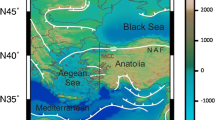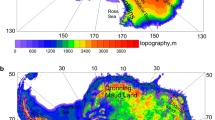Abstract
The Azores Archipelago is believed to be the site of the third arm of a Triple Junction between the Eurasia/Africa/North America plates. However, to the present no study has been able to identify its segmentation pattern, the spreading mechanism and its relationship with the well-known topographic features of the Mid-Atlantic Ridge (MAR). Here we present a new gravity compilation obtained with the existing National Geophysical Data Center (NGDC) data, merged with new gravity profiles collected during the ESCAPE cruise in 1995. This compilation is used to calculate a Free Air Anomaly (FAA) map, which is used to test two different models, the Mantle Bouguer Anomaly model and the elastic plate model, for the study of the thermal regime of the Terceira Axis. The analysis of the results from both models demonstrates that the elastic plate model successfully models the gravity data from the Azores Plateau and that there is no gravity evidence for the existence of a spreading axis. The elastic plate thickness Te, with a value of 7–8 km, suggests a very young lithosphere (about 10 Ma) at the time of the load of the Azores Plateau.
Similar content being viewed by others
References
Banks, R., Parker, R. and Huestis, S., 1977, Isostatic compensation on a continental scale: local versus regional mechanisms. Geophys. J. Roy. Astron. Soc. 51: 431–452
Bougault, H., German, C. and Miranda, M., 1996, MARFLUX/ATJ mid Atlantic ridge: Hydrothermal fluxes at the Azores Triple junction, InterRidge News 5(2): 13–17.
Buforn, E., Udias, A. and Colombas, M., 1987, Seismicity, source mechanisms and tectonics of the Azores-Gibraltar plate boundary. Tectonophys. 152: 89–118.
Calmant, S. and Cazenave, A., 1987, Anomalous elastic thickness of the ocean lithosphere in the south-central Pacific. Nature 328: 236–238.
Cochran, J., 1979, An analysis of isostasy in the World's Oceans 2. Mid Ocean Ridge Crests. J. Geophys. Res. 84: 4713–4729.
DeMets, C., Gordon, R., Argus, D. and Stein, S., 1990, Current plate motions. Geophys. J. Roy. Astron. Soc. 101: 425–478.
Detrick, R., Needham, H. and Renard, V., 1995, Gravity anomalies and crustal thickness variations along the Mid-Atlantic Ridge between 33° N and 40° N. J. Geophys. Res. 100: 3767–3787.
Géli, L., Renard, V. and Rommevaux, C., 1994, Ocean crust formation processes at very slow spreading centers: A model for the Mohns Ridge, near 72° N, based on magnetic, gravity, and seismic data. J. Geophys. Res. 99: 2995–3013.
German, C, Parson & HEAT Scientific Team, 1996, Hydrothermal exploration near the Azores Triple Junction: tectonic control of venting at slow-spreading ridges? Earth and Planetary Sci. Letters 138: 93–104.
Grimison, N. and Chen, W., 1986, The Azores-Gibraltar plate boundary: focal mechanism, depths of earthquakes and their tectonic implications. J. Geophys. Res. 92: 2029–2047.
Hall, S., Casey, J. and Elthon, D., 1986, A possible explanation of gravity anomalies over mid-ocean ridges. J. Geophys. Res. 91: 3724–3738.
Hirn, A., Haessler, H., Hoang Tronc, P., Wittlinger, G. and Mendes Victor, L. A., 1980, Aftershock sequence of the January 1, 1980, earthquake and present-day tectonics in the Azores. Geophys. Res. Letters 7: 501–504.
Kostoglodov, V., Kogan, M. and Magnitskaya, E., 1981, Isostasy of the Southern Mid-Atlantic Ridge: long-wavelength and short-wavelength effects. J. Geophys. Res. 86: 7825–7841.
Krause, D. C. and Watkins, N. D., 1970, North Atlantic crustal genesis in the vicinity of Azores. Geophys. J. R. Astron. Soc. 19: 261–283.
Kuo, B-Y. and Forsyth, D., 1988, Gravity anomalies of the ridge-transform system in the South Atlantic between 31 and 34.5° S: Upwelling centers and variations in crustal thickness. Mar. Geophys. Res. 10: 205–232.
Lewis, B., 1981, Isostasy, magma chambers, and plate driving forces on the East Pacific Rise. J. Geophys. Res. 86: 4868–4880.
Lewis, B., 1982, Constraints on the structure of the East Pacific Rise from gravity. J. Geophys. Res. 87: 8491–8500.
Lin, J., Purdy, G., Schouten, H., Sempéré: J.-C., and Zervas, C., 1990, Evidence from gravity data for focused magmatic accretion along the Mid-Atlantic Ridge. Nature 344: 627–632.
Lourenço, N., Miranda, J. M., Luis, J. F., Ribeiro, A. and Mendes Victor, L. A., Morpho-structural interpretation of the Azores Plateau from a new bathymetric compilation. Mar. Geophys. Res. (in press).
Luis, J. F., 1996, Le Plateau des Açores et le Point Triple Associé: Analyse Géophysique et Evolution, PhD Thesis, Paris VII, Paris.
Madsen, J., Forsyth, D. and Detrick, R., 1984, A new isostatic model for the East Pacific Rise Crest. J. Geophys. Res. 89: 9997–1015.
McKenzie, D. and Bowin, C., 1976, The relationship between bathymetry and gravity in the Atlantic Ocean. J. Geophys. Res. 81: 1903–1915.
McNutt, M., 1979, Compensation of oceanic topography, an application of the response function technique to the Surveyor area. J. Geophys. Res. 84: 7589–7598.
Miranda, J. M., Mendes Victor, L. A., Simões, J. Z., Luis, J. F., Matias, L., Shimamura, H., Shiobara, H., Nemoto, H., Mochizuki, H., Hirn, A. and Lépine, J. C., 1999, Tectonic setting of the Azores Plateau deduced from a OBS survey. Mar. Geophys. Res. (submitted).
Morris, E. and Detrick, R., 1991, Three-dimensional analysis of gravity anomalies in the MARK area, Mid-Atlantic Ridge 23° N. J. Geophys. Res. 96: 4355–4366.
Neumann, G. and Forsyth, D., 1993, The paradox of the axial profile isostatic compensation along the axis of the Mid-Atlantic Ridge? J. Geophys. Res. 98: 17891–17910.
Parker, R. L., 1972, The rapid calculation of potential anomalies. Geophys. J. Roy. Astron. Soc. 31: 447–455.
Prince, R. and Forsyth, D., 1988, Horizontal extent of anomalously thin crust near the Vema Fracture Zone from three-dimensional analysis of gravity anomalies. J. Geophys. Res. 93: 8051–8063.
Purdy, G. and Detrick, R., 1986, Crustal structure of the Mid-Atlantic Ridge at 23° N from seismic refraction studies. J. Geophys. Res. 91: 3739–3762.
Rommevaux, C., Deplus, C., Patriat, P. and Sempéré: J. C., 1994, Three-dimensional gravity study of the Mid-Atlantic Ridge: Evolution of the segmentation between 28° and 29° N during the last 10 m.y. J. Geophys. Res. 99: 3015–3029.
Sandwell, D. and Smith, H. F., 1997, Marine gravity from Geosat and ERS-1 satellite altimetry. J. Geophys. Res. 102: 10039–10054.
Searle, R., 1976, Lithospheric structure of the Azores Plateau from Rayleigh-Wave dispersion. Geophys. J. Roy. Astron. Soc. 44: 537–546.
Searle, R., 1980, Tectonic pattern of the Azores spreading centre and triple junction. Earth Planetary Sci. Lett. 51: 415–434.
Smith, W. and Wessel, P., 1990, Gridding with continuous curvature splines in tension. Geophysics 3: 293–305.
Turcotte, D. L. and Schubert, G., 1982, Heat transfer. In J. W. & Sons (eds), Geodynamics. Applications of Continuous Physics to Geological Problems: John Wiley & Sons, New York, pp. 135–197.
Udias, A., Lopez Arroyo, A. and Mezcua, J., 1976, Seismotectonics of the Azores Alboran region. Tectonophysics 31: 259–289.
Watts, A., 1978, An analysis of Isostasy in the World's Oceans 1. Hawaiian-Emperor Seamount Chain. J. Geophys. Res. 83: 5989–6004.
Wessel, P., 1989, XOVER: A cross-error detector for track data. Computers & Geosciences 15: 333–346.
Author information
Authors and Affiliations
Rights and permissions
About this article
Cite this article
Luis, J., Miranda, J., Galdeano, A. et al. Constraints on the structure of the Azores spreading center from gravity data. Marine Geophysical Researches 20, 157–170 (1998). https://doi.org/10.1023/A:1004698526004
Issue Date:
DOI: https://doi.org/10.1023/A:1004698526004




